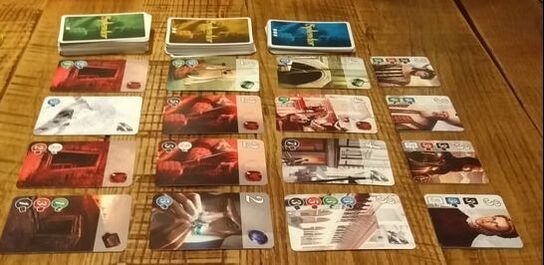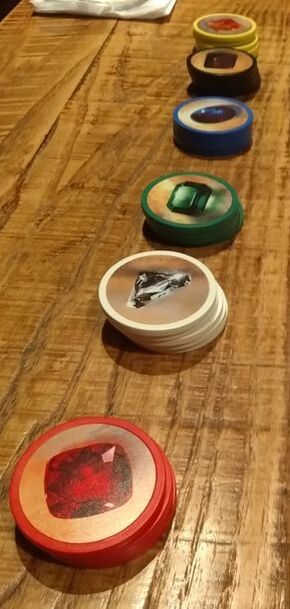|
23rd April 2019. Gaming night at 'The Sovs' in Woking continues with the second game of the night; 'Splendor'. Splendor is a engine building card game. Hang on! Just earlier this very tonight we played 'Race for the Galaxy' another engine building card game. This is quite interesting, because they are 2 similar but different games. So without further preamble, here we go. What's in a game? The set up for Splendor is pretty simple. There are 3 decks of 'Development Cards' (decks 1, 2 & 3) that you shuffle and place in a column in ascending order.. Then, from each deck you deal a row of 4 cards. So now you have 12 cards in total from the 3 decks displayed face up. Then you place the 'Noble' tiles, you always put out one more noble tile than the number of players. Finally you place out the tokens: These come in 6 colours, 5 normal colours and gold (which is wild). That's it for set up. How's it play? Players can perform only one of three possible actions in their turn.
Development Cards
All development cards have a cost (In Tokens.), this might be 2 white and 2 black, or 1 white, 1 black, 1 red & 1 blue, etc. The cost increases according to the row they are in. What does buying a development card get you? They give you 1 or 2 things. Every development will give you a 'bonus' token in one of the 5 colours. This bonus is permanently available to you. Thus; if you have bought a card that gives you 1 'white bonus' and want to buy a card which costs 2 white and 2 black, you would only need to have 1 white and 2 black tokens - the bonus on the development card counts as 1 white token. The more cards acquired, the easier it gets to buy other cards. Eventually you'll reach a point where you be able to buy lesser development cards 'for free'. The other thing that you get from development cards are victory points. Level 1 cards will sometimes give you a victory point. Level 2 cards tend to give you 1-2 victory points. Level 3 cards will give you up to 5 victory points. Noble Tiles Noble tiles provide extra points to the player that manages to acquire them. Like development cards, noble cards have a cost. This might be 4 red & 4 blue or 3 green, 3 black & white etc. However, unlike development cards, tokens cannot be used to buy noble tiles. Only the bonuses accumulated from development cards can be used to do so. Additionally; acquiring a noble tile does not count as an action and it can bought immediately after a development card has been bought. Endgame When a player has accumulated at least 15 points, then endgame is triggered. The endgame is simple, all players who have not acted in the turn get their turns, so everybody has had an equal number of turns. Overall Splendor seems like a simpler engine building game than the mechanically deeper Race for the Galaxy. But there's hidden depth that emerges with higher level play. Splendor requires all players to have their cards, tiles and openly displayed for all to see. Only cards that you reserved are hidden in your hand. And in Splendor, you need to spend time looking at what your opponents are doing and trying to gauge which cards or nobles they are trying to buy. This stops you from trying to build an engine to try and get card that they're going to get first. Or gives you a target to try and get before them. Hidden reserve cards can prove important too, because they allow you to spring surprises on your opponents. I like Splendor, it's quick to set up and teach and quick to play - well unless your players suffer from analysis paralysis! Overall: a worthy engine building game.
0 Comments
Leave a Reply. |
AuthorI play, I paint. Archives
March 2024
Categories
All
|



 RSS Feed
RSS Feed
